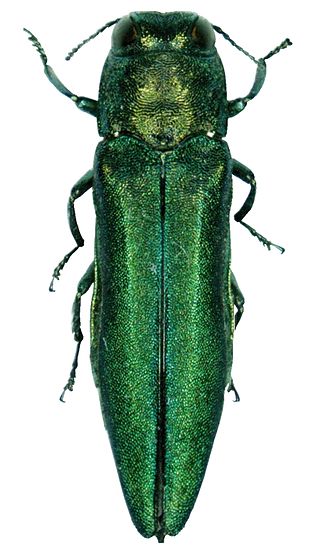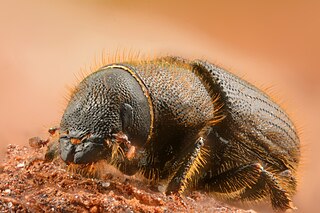
Yellowjacket or yellow jacket is the common name in North America for predatory social wasps of the genera Vespula and Dolichovespula. Members of these genera are known simply as "wasps" in other English-speaking countries. Most of these are black and yellow like the eastern yellowjacket and the aerial yellowjacket ; some are black and white like the bald-faced hornet. Others may have the abdomen background color red instead of black. They can be identified by their distinctive markings, their occurrence only in colonies, and a characteristic, rapid, side-to-side flight pattern prior to landing. All females are capable of stinging. Yellowjackets are important predators of pest insects.

The Asian long-horned beetle, also known as the starry sky, sky beetle, or ALB, is native to the Korean Peninsula, northern and southern China, and disputably in northern Japan. This species has now been accidentally introduced into the eastern United States, where it was first discovered in 1996, as well as Canada, and several countries in Europe, including Austria, France, Germany, Italy and UK.

The longhorn beetles (Cerambycidae), also known as long-horned or longicorns, are a large family of beetles, with over 35,000 species described. Most species are characterized by extremely long antennae, which are often as long as or longer than the beetle's body. In various members of the family, however, the antennae are quite short and such species can be difficult to distinguish from related beetle families such as the Chrysomelidae. The scientific name of this beetle family goes back to a figure from Greek mythology: after an argument with nymphs, the shepherd Cerambus was transformed into a large beetle with horns.

The emerald ash borer, also known by the acronym EAB, is a green buprestid or jewel beetle native to north-eastern Asia that feeds on ash species. Females lay eggs in bark crevices on ash trees, and larvae feed underneath the bark of ash trees to emerge as adults in one to two years. In its native range, it is typically found at low densities and does not cause significant damage to trees native to the area. Outside its native range, it is an invasive species and is highly destructive to ash trees native to Europe and North America. Before it was found in North America, very little was known about emerald ash borer in its native range; this has resulted in much of the research on its biology being focused in North America. Local governments in North America are attempting to control it by monitoring its spread, diversifying tree species, and through the use of insecticides and biological control.

A bark beetle is the common name for the subfamily of beetles Scolytinae. Previously, this was considered a distinct family (Scolytidae), but is now understood to be a specialized clade of the "true weevil" family (Curculionidae). Although the term "bark beetle" refers to the fact that many species feed in the inner bark (phloem) layer of trees, the subfamily also has many species with other lifestyles, including some that bore into wood, feed in fruit and seeds, or tunnel into herbaceous plants. Well-known species are members of the type genus Scolytus, namely the European elm bark beetle S. multistriatus and the large elm bark beetle S. scolytus, which like the American elm bark beetle Hylurgopinus rufipes, transmit Dutch elm disease fungi (Ophiostoma). The mountain pine beetle Dendroctonus ponderosae, southern pine beetle Dendroctonus frontalis, and their near relatives are major pests of conifer forests in North America. A similarly aggressive species in Europe is the spruce ips Ips typographus. A tiny bark beetle, the coffee berry borer, Hypothenemus hampei is a major pest on coffee plantations around the world.

Cleridae are a family of beetles of the superfamily Cleroidea. They are commonly known as checkered beetles. The family Cleridae has a worldwide distribution, and a variety of habitats and feeding preferences.

Hylobius abietis or the large pine weevil is a beetle belonging to family Curculionidae. This species is widely regarded as the most important pest of most commercially important coniferous trees in European plantations. Seedlings planted or arising from natural regeneration after clear felling operations are especially at risk. The adult weevils cause damage by eating the bark of seedlings around the 'collar' of the stem, thus 'ring-barking' the tree seedling which usually results in its demise.

Tomicus piniperda, the common pine shoot beetle, is a bark beetle native throughout Europe, northwestern Africa, and northern Asia. It is one of the most destructive shoot-feeding species in northern Europe.

Xanthogaleruca luteola, commonly known as the elm-leaf beetle, is a beetle species in the family Chrysomelidae that is native to Europe but invasive in other parts of the world.

Xanthocryptus novozealandicus, the lemon tree borer parasite, is a wasp in the family Ichneumonidae. It is a native insect of New Zealand. It is also found in Australia and New Guinea. Females hunt for larvae of wood-boring beetles around March, including the lemon tree borer, a native cerambycid that tunnels into citrus trees, grapes and many native species. When a suitable host is found, the female pushes her ovipositor through the wood and injects her eggs into the grub. This has the incidental benefit of helping to control some pests. X. novozealandicus prefers to prey on second year lemon tree borer larvae. This specific parasite prefers to prey on larger second year larvae due to its larger size.

The European spruce bark beetle, is a species of beetle in the weevil subfamily Scolytinae, the bark beetles, and is found from Europe to Asia Minor and some parts of Africa.

Agrilus auroguttatus is a species of jewel beetle in the United States, known by the common name goldspotted oak borer. It is a woodboring beetle best known for destroying stands of oak trees in the Cleveland National Forest in San Diego County, California, in the United States. It was originally considered a subspecies of the Central American species Agrilus coxalis, and much of the literature refers to it by this name, but now it is regarded as a separate species, known only from Arizona and California.

Amylostereum is the single genus in the fungal family Amylostereaceae. The genus currently comprises four saprotrophic and parasitic species, which live off living or dead wood. The Amylostereaceae cause white rot in the wood by disintegrating the tissue component lignin. They produce crust-like, partially wavy fruit bodies on the surface of infested trees, which are similar to those produced by Stereum species.

Tetropium fuscum, the brown spruce longhorn beetle, is a species of beetle in the family Cerambycidae. It was described by Johan Christian Fabricius in 1787. Tetropium fuscum is native to Europe and Northern Asia, and has been introduced to Nova Scotia, Canada. Brown spruce longhorn is a pest of spruce trees.

Lymantria dispar dispar or LDD moth, commonly known as the gypsy moth, European gypsy moth, North American gypsy moth, or spongy moth, is a species of moth in the family Erebidae that is of Eurasian origin. It has a range that extends over Europe, Africa, and North America.

Hylastes ater is a species of beetle in the family Curculionidae, the true weevils. It is a bark beetle, a member of the subfamily Scolytinae. Its common name is the black pine bark beetle. It is native to Europe and parts of Asia, including China and Korea. It is known as an introduced species in many other regions, including Australia, New Zealand, the Americas, and South Africa. It is a pest of pines and other trees, and it is widespread in areas where pine trees are cultivated. The species "is an important threat to the biosecurity of all forested countries."

Phoracantha semipunctata, the Australian Eucalyptus longhorn, is a species of beetle in the family Cerambycidae. Native to Australia, it has now spread to many parts of the world, including practically all countries where tree species of Eucalyptus have been introduced. It has been classified as an invasive pest species of Eucalyptus outside Australia.

Agrilus biguttatus is a species of beetle in the family Buprestidae, the jewel beetles. Common names include oak splendour beetle, oak buprestid beetle, and two-spotted oak borer. It is native to Europe, North Africa, and Siberia. This beetle is known as a pest that causes damage to oak trees and is a factor in oak decline.

Euwallacea fornicatus is a species complex consisting of multiple cryptic species of ambrosia beetles, known as an invasive species in California, Israel and South Africa. The species has also been unintentionally introduced into exotic greenhouses in several European countries. As the rest of the ambrosia beetles, E. fornicatus larvae and adults feed on a symbiotic fungus carried in a specific structure called mycangium. In E. fornicatus, the mycangium is located in the mandible. The combination of massive numbers of beetles with the symbiotic fungus kills trees, even though the fungus alone is a weak pathogen.

Dendroctonus micans, the great spruce bark beetle, is a species of bark beetle native to the coniferous forests of Europe and Asia. The beetles burrow into the bark of spruce trees and lay eggs which develop into larvae that feed on the woody layers under the bark.




















